4. Employment rate remained good among fathers during the economic downturn
The economic downturn which began towards the end of 2008 lowered especially men’s employment. However, the employment rate among fathers with children aged under 18 has remained good despite the recession. Figure 20 shows that although in the 20 to 59 age group employment decreased among both fathers and men without children, the employment rate declined by relatively less among fathers and remained close to 90 per cent even in 2009. The situation was best among fathers of under three-year-old children whose employment rate stayed nearly unchanged.
Among men without children the employment rate was only 73 per cent in 2009. In all age groups the employment rate was lower for men without children than for fathers.
Figure 20. Employment rates for 20 to 59-year-old fathers and men without children in 2004–2009
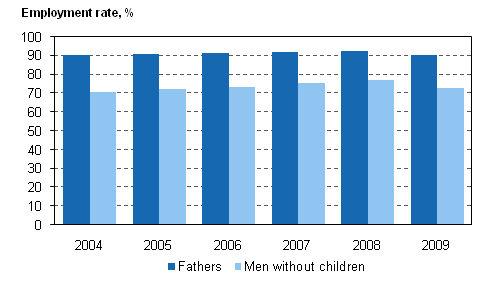
Unemployment became clearly more widespread among men without children than among fathers of children aged under 18 (figure 21). Between 2008 and 2009, the unemployment rate for men without children rose from seven to eleven per cent. By contrast, unemployment increased by clearly less than this among fathers whose unemployment rate was only around four per cent in 2009.
Figure 21. Unemployment rates for 20 to 59-year-old fathers and men without children in 2004–2009
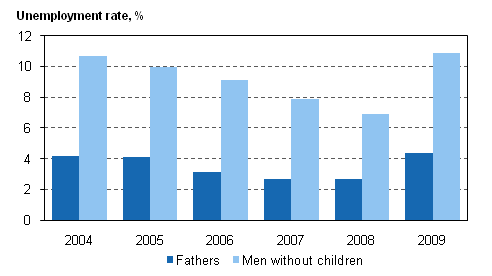
Thus, men without children experienced more of the temporary lay-offs, redundancies and increase in unemployment which followed from the recession. Fathers of families with children have remained firmly in working life and their employment rate has stayed high and unemployment rate low despite the recession.
4.1 More mothers did not stay at home because of the recession
The economic downturn had little effect on women’s employment. In 2009, the employment rate for 20 to 59-year-old mothers was about 76 per cent, which was two percentage points lower than in the previous year. The employment rate for women without children in the same age group stayed at 78 per cent. Unlike with men, the difference between the employment rates for women without children and for mothers was thus very small.
In recent years, employment rates have been very similar from one year to the next for women without children and for mothers. (Figure 22.)
Figure 22. Employment rates for 20 to 59-year-old mothers and women without children in 2004–2009
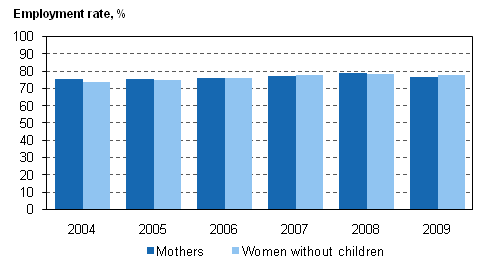
The age of the youngest child has a clear impact on the mothers’ employment (figure 23). Only about one-half of mothers are employed if their youngest child is aged under three. Mothers’ employment rate rises to 90 per cent or so, i.e. same level as fathers’, only once the youngest child has reached school age. Fathers’ employment rate, in turn, remains equally high irrespective of the age of his children. This means that mothers still continue to take most of the long family leaves.
Figure 23. Employment rate for 20 to 59-year-old mothers by age of youngest child in 2004–2009
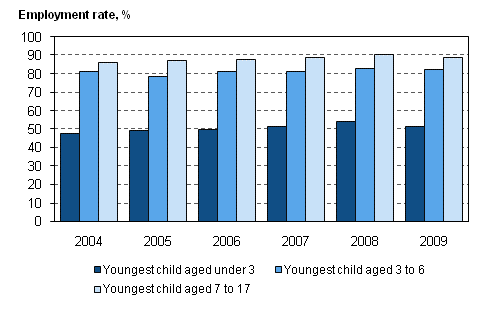
Mothers’ use of family leaves has remained unchanged
The employment rate alone does not reveal the proportion of the parents of young children who actually work. Persons on maternity or paternity leave from work as well as persons whose absence from work has lasted under three months are classified as employed in the Labour Force Survey. Thus, especially in the case of mothers of very small children the employed include a lot of mothers who are actually at home looking after a child. Respectively, mothers on child care leave are mostly classified as persons outside the labour force even if they have a valid employment contract because the child care leave is often taken immediately after the maternity leave and parental leave, which lengthens the total duration of the leave.
Figure 24 shows as a separate group those mothers of under three-year-old children who actually go to work. It also describes separately the mothers on family leave (maternity, parental or child care leave) from a valid employment contract and the mothers without a valid employment contract who are looking after their children at home. The category of other non-employed persons includes e.g. students or unemployed persons.
Figure 24. Working and family leaves of 20 to 59-year-old mothers with children aged under three in 2008–2009
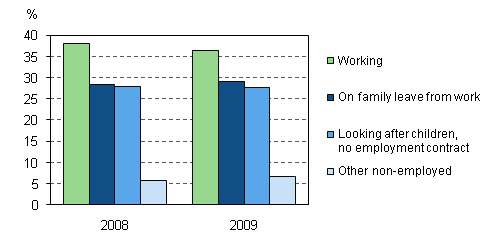
The results obtained by examining the working of mothers this way are very similar to the results reported above from the examination of employment rates. The economic downturn that started at the turn of 2008/2009 does not seem to be reflected in the working of mothers of small children so that more of them would have decided to stay at home to look after their children. The shares of mothers on family leave or without a valid employment contract and caring for their children among all mothers of children aged under three were almost the same in 2009 and 2008 (figure 24).
When the mothers on family leaves are separated from those working, in reality only about one-third of the mothers of under three-year-olds were working in 2009. However, the groups of mothers of under one-year-olds and mothers of one to two-year-olds are very different (figure 25). Of the mothers whose youngest child was aged under one, fewer than nine per cent were working, over one-half were on a family leave and good one-third were at home caring for the child and did not have a valid employment contract. When the youngest child was aged between one and two, as many as over one-half of the mothers were working. Thus, the share of mothers who work rises fast as the youngest child grows older because the mothers either return to work from family leave or find employment.
Figure 25. Working and family leaves among 20 to 59-year-old mothers by age of youngest child in 2009
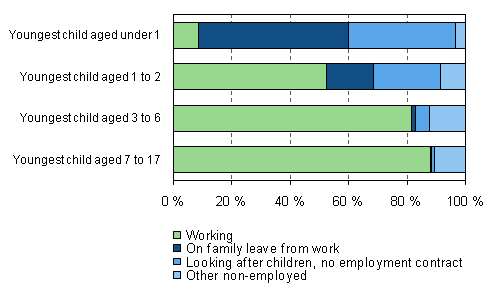
Fathers usually take shorter family leaves than mothers. During the paternity leave, the “daddy” month or the child care leave lasting under three months fathers are classified as employed so family leaves have little impact on the employment rate of fathers. However, the picture of the employment of fathers hardly changes when the fathers on family leave are separated from the fathers who are working, because only two per cent of the fathers of under three-year-olds were on a family leave during the survey week in 2009.
More mothers stay at home after the arrival of third child
Apart from the age of children, their number also influences the employment of mothers (figure 26). In 2009, 82 per cent of the mothers of two children were employed but only 65 per cent of mothers were still employed if there were at least three children. The number of children has no impact on the employment of fathers.
Figure 26. Employment rates of fathers and mothers aged 20 to 59 by number of children in 2009
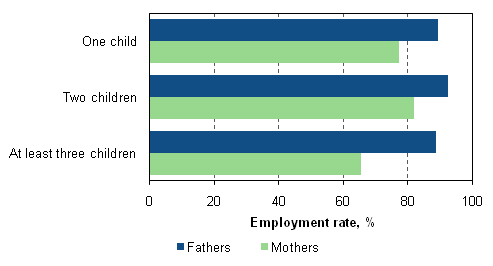
Indeed, staying at home is clearly more usual for the mothers of families with three or more children than among the mothers of families with one or two children. One in five of the mothers of families with at least three children were looking after the children at home and had no valid employment contract in 2009 (figure 27). Working and looking after children were nearly equally common among the mothers of one child or two children. The groups differed slightly only because the mothers of one child are more often outside working life for some other reason, such as studying.
Figure 27. Working and family leaves among 20 to 59-year-old mothers by number of children in 2009
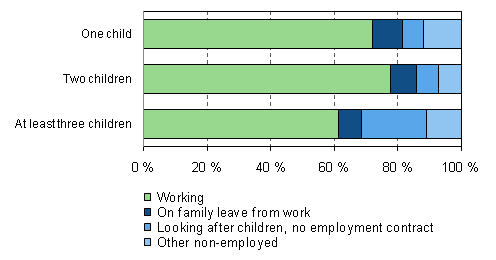
4.2 Both parents of families with children are usually employed
If a family with children has two carers both of them are usually employed. Both the father and the mother were employed in around 70 per cent of two-carer families with children in 2009. When the children are small the father usually works and the mother stays at home caring for the children. However, this arrangement lasts for a relatively short time period and the so-called dual-earner model becomes usual as the youngest child grows older. Both parents are employed in nearly 80 per cent of the two-parent families where the youngest child is aged over three (figure 28).
Figure 28. Labour market status of parents in dual-carer families with children by age of youngest child in 2009
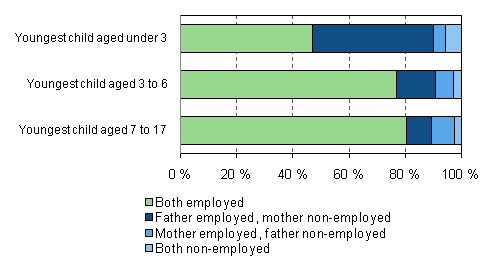
In three out of four of the two-parent families where the youngest child was aged under one the father was working and the mother was either on family leave or otherwise caring for the children at home. If the youngest child was aged between one and two this situation only applied to about every third family and in every second family the mother, too, had returned to work.
Thus, in respect of the parents’ participation in working life the set-up is still very traditional in the majority of families with small children. The mother was working while the father cared for the children in only about one per cent of the families with children aged under three in 2009.
4.3 Concepts
Parents of families with children are women and men with their own or their spouse’s children aged under 18 living in the same household.
Women and men without children are women and men without children aged under 18 living in the same household. Thus they include:
-
Persons without any children
-
So-called long distance parents whose children live and are registered at the address of the other parent
-
Parents whose children are aged over 18 or have already moved into their own household.
In this review, 20 to 59-year-old women and men without children have been compared with parents of families with children in order to improve the comparability of these groups in respect of age and stage in life. More than 99 per cent of the parents of children aged under 18 locate in this age group.
Family leaves comprise maternity and paternity leave, parental leave (incl. so-called “daddy” month) and child care leave. They are leaves which the parents of small children are entitled to take by law from work in order to care for their children until the youngest child reaches the age of three. The employment contracts of the parents remain valid during these family leaves. Persons on maternity or paternity leave and persons on leaves lasting under three months are classified as employed in the Labour Force Survey.
Source: Labour force survey 2009. Statistics Finland
Inquiries: Heidi Melasniemi-Uutela (09) 1734 2523, Olga Kambur (09) 1734 3565, tyovoimatutkimus@stat.fi
Director in charge: Riitta Harala
Updated 3.12.2010
Official Statistics of Finland (OSF):
Labour force survey [e-publication].
ISSN=1798-7857. 17 2009,
4. Employment rate remained good among fathers during the economic downturn
. Helsinki: Statistics Finland [referred: 22.12.2025].
Access method: http://stat.fi/til/tyti/2009/17/tyti_2009_17_2010-12-03_kat_004_en.html

